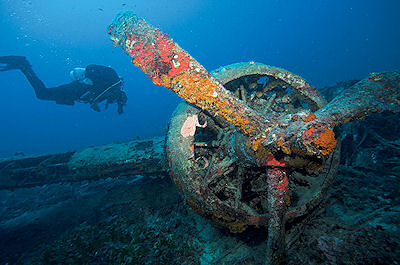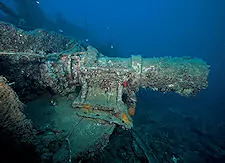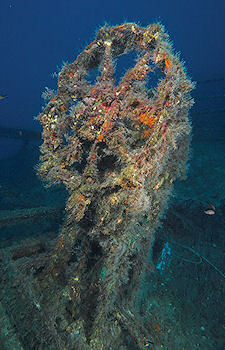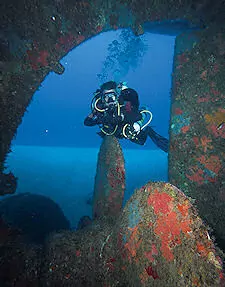This is your assignment if you choose to take it – dive the Maltese island wrecks and compile a load of ‘Top Five’ tables. John Liddiard takes up the challenge.
THE TASK OF ROUNDING UP the best wreck dives of Malta, sport and technical, is the sort of challenge with which I can have fun.
I begin by ensuring that the scope of the project is fair, because we can’t leave out Gozo, and there may soon be a wreck off Comino.
Sitting down with the latest edition of Peter Lemon’s book Scuba Diving – Malta, Gozo, Comino, I start making lists.
There are quite a few wrecks I have not dived yet. Some I have simply missed out on, because I have not done anything technical from Malta or Gozo and, in one case, because it was not sunk last time I was there.
It’s the perfect excuse to revisit, this time taking a rebreather so that I can do the technical wrecks in comfort and without costing a fortune in helium, and also so that I can get plenty of time on the wrecks in sport-diving depths.
Even so, I have to set a limit, and decide to draw the line at 75m.
Arriving at the Oxygène Malta dive centre fresh from the flight, I don’t want to start with anything too serious.
I may have had a nice flight with Air Malta, but did my kit have a nice time with the baggage-handlers?
We load up onto captain Jason’s boat Delfino and head out to the wreck of a Bristol Blenheim bomber that ditched on 13 December, 1941.

At 38m down with an optimum nitrox mix, I have an easy 25 minutes on the wreck, with no mandatory deco stops.
This wreck is mostly radial engines and wing, with a bit of the tail-end of the fuselage bumped forward of the cockpit area. The starboard engine boasts a bent propeller.

The prop from the port engine was shot off by the attacking Italian Macchi C200 fighter. It’s a nice little wreck, deserving to be on my list.
A few metres deeper is HMS Hellespont, a steam-paddle tug first sunk in the harbour during an air raid on 6 April, 1942, then raised and dumped outside in 42m.
Most of the damage is to the forward part of the wreck. A nice helm remains, just forward of the paddle-shaft amidships. The paddle wheels were removed, but the shafts and engines are still there.

Typically good Mediterranean visibility helps me enjoy a wreck that would be well visited if it were off Brighton or Weymouth. Another good candidate.
Having settled in, I move on to the deepest wreck of the trip, the Hunt-class destroyer HMS Southwold, blown in two by a floating mine on 23 March, 1942.
With its two halves separated, Southwold is really two dives, but it is only one wreck, so I elect to dive the upright stern in 73m.
Deep enough to be below most of the algal growth that dominates shallower dives, sponges add brightly splashed colour to guns, depth charges and scattered ammunition. There is no way I can leave the Southwold off my list.
My next wreck is one of Malta’s artificial reefs. In the 1970s, the Imperial Eagle served as a ferry between Malta and Gozo, then lay unused in the harbour until being cleaned up, towed offshore and scuttled on 19 July, 1999.

At 38m to the scour beneath the propeller, most of this wreck is within the 35m BSAC Sports Diver limit.
While it’s fun to swim through the passenger deck, highlights are the helm, complete with wheel, then a larger-than-life statue of Christ 50m off the bow, though that doesn’t count as part of the wreck.
While not yet a candidate for any best wrecks list, a similar tripper boat and ferry, Atlantic Ocean, is moored derelict in the harbour and rumoured to be destined to become an artificial reef once a suitable site is found.

Nearby, the Lady Davina has sunk at its mooring in the harbour. It will need to be raised to clear the obstruction, but could easily become another artificial reef rather than being returned to service.
Meanwhile it serves as a temporary attraction for shore-divers just along from the Oxygène centre.
Our dive-boat could never suffer such a fate.
A traditional Maltese fishing hull, Jason keeps Delfino in immaculate condition from stem to stern, above and below the water-line. Even the engine-room is pristine.
Back in trimix depth, at 66m the German E-boat or “Schnellboot” S31 is a complete warship of compact size, with guns, ammunition, engines, triple props and rudders at the stern and twin torpedo-tubes at the bow. There is also the hub of the ship’s wheel on the helm.
As on HMS Southwold, a predominant covering of sponges provides vibrant colour to a generally darker dive on a cloudy day.

I note in my logbook yet another wreck vying for the top of my list.
The 3147-ton tanker Um-el-Faroud is a wreck I have dived previously from the shore, and written of as world-class.
From a boat the dive is better still; more time on the wreck and none lost swimming out to it. Even so, I don’t have time to explore every compartment.
The Um-el-Faroud was sunk as an artificial reef on 2 September, 1998. A plaque on the front of the wheelhouse commemorates dockyard workers killed by a fire that gutted the tanker in 1995.

Having served extensively in World War Two, the S-class submarine HMS Stubborn was actually sunk on 30 April, 1946, as a sonar target.
At 55m to the seabed, some dive this wreck on air, though I stick with trimix diluent.
The wreck is intact, though stripped of many features before sinking. Again a bit deep for algae, there are some wonderfully coloured sponges on the hull, particularly beneath the tail.
My list of best wrecks is filling up fast, and I still have plenty to dive.
On the immediate approach to the Grand Harbour are the wartime wrecks of the minesweepers HMS Eddy and HMS St Angelo. Both were sunk by mines, on 25 May and 30 May, 1942, respectively, at a seabed depth of 58m.
We wait for large cruise ships and freighters to pass before diving. I am enjoying the Eddy and busy taking photographs when Karl holds up his slate with the message “Not Eddy, St Angelo” scribbled on it.
The wrecks are less than 100m apart, and Jason had dropped the shot on the wrong wreck.
Nevertheless, this Royal Navy tug-come-minesweeper is a cracking little dive, with a telegraph and the hub of the ship’s wheel still in place, generator, sweeping cables and toilet.

Jason takes a fair bit of ribbing about the wrong wreck. But apart from the labelling on his GPS, the shot was bang in the middle of the bow deck, and he does put me on the Royal Navy drifter Eddy later.
The Eddy is a slightly larger wreck with twin propellers, compared to the St Angelo’s single shaft. The highlights for me are the minesweeping fish lying crushed off the stern, several clusters of machine-gun ammunition, the helm and the steering-engine.

Both Eddy and St Angelo deserve to be on my final list, but I can’t decide which is the better dive.
Jason drops the shot on the wreck of a Bristol Beaufighter, ditched in 38m following an engine problem on 17 March, 1943.

We ask if he is sure the shot is not on the Blenheim bomber again, even though that wreck is located halfway round the island.
On white sand, the compact Beaufighter stands out as a complete set of wings and engines, though the tail part of the fuselage is missing.
It is smaller than the Blenheim and rests upside-down, which shows off nicely the quad 20mm cannon under the nose. I must now decide which is the better aircraft wreck!

We step back in time to the World War One wreck of the French liner and troopship Le Polynesian, torpedoed by UC22 on 10 August, 1918, and resting in 65m. The descent starts as usual in perfectly slack water.

Then the current builds to the point where it is ripping across the wreck for the last few metres.
I find shelter on the main deck, which lists to port. Jason has placed the shot amidships, so I run straight into Polynesian’s famous piles of crockery, though I don’t have time to see the guns at bow and stern. My list grows again.
I finish my diving with Oxygène with three shallower wrecks that I have dived previously from shore, but now do by boat.
The tugboats 10 and St Michael are a single dive, but it is two wrecks and I am counting wrecks, not dives, for this project. Both are small and sit upright on the sand in 20m.

For a comparison, 10 is slightly smaller than Stoney Cove’s Stanegarth, St Michael is slightly larger. Both were scuttled on 16 May, 1998.
The final wreck is HMS Maori, a Tribal-class destroyer, sunk in the Grand Harbour by a German bomb on 12 February, 1942.

In 1945, the wreck was re-floated and the bow part scuttled inshore, the aft part being towed to much deeper water.
Maximum depth is only 14m and it is an easy dive, with some atmospheric views through the wreckage. As the first wreck dive for many who learn to dive in Malta, it deserves to be listed.
I move on to Gozo to dive with St Andrew’s Divers’ Cove. Gozo’s own trio of ferry wrecks can be easily dived from the shore.
An information board by the parking area gives directions to them, and even a ladder to assist exit.
The double-ended car ferry Xlendi was sunk on 12 November, 1999, unfortunately rolling in the process and landing upside-down.
When the passenger ferry and tourist boats Karwela and Cominoland were sunk on 12 August, 2006, stacks of drums for buoyancy were strapped to the tops to hold them upright. All three lie roughly in line in 42m.

I first dived these two soon after they were scuttled. Returning a couple of years later, I am pleased to see marine growth beginning to take hold, and plenty of fish about.
The pink fur on the Volkswagen Beetle that rests on the stern of Karwela is starting to lose its vibrancy. Perhaps we should send the Dive Girl team out to spruce it up.

Because it is inverted, Xlendi is a less interesting dive for those not into serious wreck penetration.
Signs outside warn against this and, particularly following a recent death, only divers suitably experienced, prepared and properly equipped for line-laying should contemplate exploring deep inside the upturned hull.
Those in the know about Malta’s wrecks will have noticed two notable absences. Never fear, I have not missed the Rozi or P29. It is just easier for me to do them as boat dives from Gozo.

With Mark at the helm of St Andrew’s fast dive-boat Divemania, it’s only a 15-minute ride back to Cirkewwa at the tip of Malta from Mgarr on Gozo.

The ex-East German and then Armed Forces of Malta patrol-boat P29 was sunk off Cirkewwa only on 14 August 2007, about 100m from the tug Rozi, which was scuttled in 1992.

It is possible to see both in one long and fast swimming dive, but they qualify as two separate wrecks, and I make separate dives on separate days to see them.
P29 sits upright in 38m, and for a small patrol boat there is plenty to keep me busy. With military-grade paintwork to get through there is little marine growth yet, but the bream have moved in, and barracuda hover in the distance.
Another patrol-boat, P31, is ready to be sunk, but awaiting the right site.

Sites have to be clean seabed with no reef or sea-grass and no risk of negative impact on any nearby marine life.
Combining such conditions with suitable diver access and a fair spread of sites around the islands is not easy.
The older Rozi was sunk as an artificial reef in 1992, originally as an attraction for a tourist submarine ride, but proved so successful with divers that it opened the way for all the artificial reefs that have followed.

I have dived this 30m-long tug before, but only from shore. A boat dive gives me much more time on the wreck.
The well-established coating of marine growth provides grazing for plenty of nudibranchs.
Above the wheelhouse of the Rozi, hordes of anthias and bream show how we can expect the P29 and other wrecks to develop in the future.

The trouble with Malta and Gozo is that there are too many wrecks. Picking the best to dive depends on the type of diving you prefer, so I hope my six Top Five tables will help.
BEST WRECKS FROM SHORE
- Rozi: The original artificial reef, with a mature coating of marine life.
- P29: Bigger and more to see than on the Rozi, but still grey paint.
- Um-el-Faroud: Fantastic wreck, though diving from the shore you are pushed for time to see it all.
- Cominoland: The smaller of Gozo’s wrecks, but seems to be a favourite.
- Karwela: For the Volkswagen Beetle with pink fur on the aft deck.
BEST WRECKS FOR OPEN WATER/OCEAN DIVERS (20M MAX)
- HMS Maori: Start your wreck-diving career with a war hero.
- St Michael: Pass the wreck 10 on the way.
- Um-el-Faroud: As a boat dive, superstructure only.
- Scot Craig: Boat dive to a less-dived wreck.
- Coralita X127: A bit murky in the harbour, but a fair amount to see with a good guide.
BEST WRECKS FROM A BOAT
- Um-el-Faroud: Because you can multi-level on the wreck, and get enough time on it to explore in detail – but you still won’t see it all.
- HMS Hellespont: For the paddle-steam machinery and helm.
- Bristol Beaufighter: For the guns, and to see it all just laid out on the sand.
- P29: Because you get enough time on it to explore in detail.
- Bristol Blenheim: A bigger aircraft, but without the guns.
BEST WRECKS FOR TECHNICAL AIR DIVING

- HMS Stubborn: Swim around the conning tower and above the deck.
- Xlendi Ferry: Wreck penetration strictly for properly equipped and experienced divers only.
- HMS Hellespont: Spend time with the paddle-steam machinery and build up some deco.
- HMS St Angelo: Stay above the deck, look in detail at the wheelhouse.
- HMS Eddy: As HMS St Angelo.
BEST TECHNICAL DIVES
- HMS Southwold: For the guns, depth charges, ammunition and colour.
- Le Polynesian: Because there is so much of it.
- Schnellboot S31: or the guns, torpedo tubes, ammunition and colour.
- HMS Stubborn: For the conning tower and detail beneath the stern.
- HMS Eddy: There is stuff on the seabed too deep for air.
WRECKS JL WOULD DIVE AGAIN

- HMS Southwold: To see the front half.
- Le Polynesian: It’s big, so well worth several dives.
- Xlendi Ferry: Local authorities and dive centers advise against penetrating this wreck.
- P29: To see how it’s developing.
- Schnellboot S31: To see what has fallen into the debris field.
FACT FILE
- GETTING THERE: Air Malta flies several times daily from Heathrow. Divers get a 35kg allowance if it’s booked in advance.
- DIVING: Malta: Oxygène, Gozo: St Andrew’s Divers’ Cove. Find other dive centers through the Professional Diving Schools Association of Malta.
- MONEY: Euro
- WHEN TO GO: Technical divers prefer winter, because in summer it gets too hot on the boat in all that kit.
- FURTHER INFORMATION: Visit Malta Tourist Office website, Ministry for Gozo website, Gozo tourism website.


